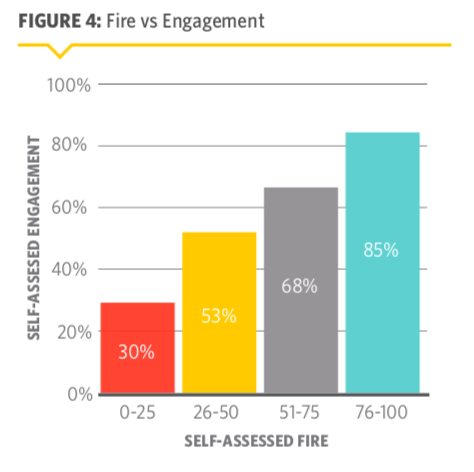Employee engagement clearly plays a critical role in the success of a company. Many have attempted to understand how engagement is created. Recent research into the causes of engagement, as well as the barriers, found some interesting results.
 Bill Bennett is the CEO of InsideOut, an organization that conducted research called “Fire and Its Impact on Workplace Performance.” In this Q&A, Bennett helps unpack the company’s findings through a simple framework that seeks to explain the fire that burns or does not burn within employees.
Bill Bennett is the CEO of InsideOut, an organization that conducted research called “Fire and Its Impact on Workplace Performance.” In this Q&A, Bennett helps unpack the company’s findings through a simple framework that seeks to explain the fire that burns or does not burn within employees.
HR Daily Advisor: Can you explain what you mean when you say an employee has “fire”?
Bennett: There are many things in life that hold us back from being 100% productive or that create some form of interference, inhibiting us from doing our best work. One of these factors is the lack of “fire,” or one’s passion, motivation, and drive. Recently, my company set out to understand how fire comes into play at work and its role in overcoming interference.
Faith, fire, and focus are elements that make up what we call the performance wheel. In any situation, we need some amount of each element to accomplish any task. Fire is especially helpful in producing the best results. In fact, our survey showed that a “fired-up” employee will produce 38% better results. In an effort to help everyone reach peak performance, our goal is to help employees be aware of their fire (motivation) level, identify what interference might be inhibiting that fire, and take steps to overcome that interference.
HR Daily Advisor: Everyone is talking about employee engagement. Is “fire” synonymous with engagement?
Bennett: While fire and engagement are not exactly the same thing, our research does show that fire is one of the largest indicators of engagement within the workplace. We discovered that the greater someone’s fire—passion, drive, or motivation—the greater the person’s self-reported
engagement. Here’s a quick graph that shows that result.
HR Daily Advisor: How charged are people showing up to work, and what does that say about their engagement and productivity?
Bennett: Our research did find that people on average feel only 68% charged up at work, but we can look at those data in a couple ways: Employees basically “sleepwalk,” or turn on autopilot, for one-third of their projects at work, or employees only give 68% of their effort on each project. At most, workers reported they feel they reach only 74% of their maximum capacity each day, and only 4% feel they work at 100%.
What this says about engagement and productivity is a little disheartening, as we’d all like to be working at max capacity, but there is hope. A lack of productivity and engagement isn’t necessarily a lack of discipline, focus, or training in your position but rather a daily fight to overcome interference. If a worker can pin down what is getting in the way and outline a plan to overcome it, it’s likely he or she will ignite the fire or motivation necessary to improve his or her engagement levels, too.
HR Daily Advisor: What’s the root cause of interference at work? Is it an individual matter? A companywide issue?
Bennett: Interference is anything that inhibits our ability to perform at our highest level. Based on that definition, interference can be personal (e.g., relationship challenges, finances, physical and mental health, etc.) or work-related.
Perhaps you have to work with a difficult colleague, are tasked with busy work, sit in the coldest section of the office, or manage unclear expectations from your manager. Management choices actually play a huge role in workplace interference and employees’ fire levels.
Our study found that 80% of workers said managers impact their fire at least monthly, while 50% report managers impact their fire weekly. This impact can be either positive or negative, but the impact is there nonetheless.
HR Daily Advisor: Did you find out how managers increase or decrease fire for their workers? What are some things to avoid, and what should they emphasize?
Bennett: Yes, we did. It’s important to us as a workplace coaching company to make sure we give managers and executives practical takeaways to help them manage these issues at work. We found that the best way to put out an employee’s fire is to micromanage. Can we really expect employees to feel motivated when they feel powerless?
There were a number of other “don’ts” that came from our survey. Respondents said making unnecessary rules (45%), having unrealistic expectations (42%), getting upset at failure rather than being encouraging (40%), and giving unclear instructions (38%) were other ways managers stifle their fire.
On the upside, managers wield a powerful sword and can do a number of things to boost employee fire. Most respondents (49%) said the best thing a manager can do to increase fire is create opportunities to learn and grow, followed closely by giving recognition (48%). Other ways include “truly” listening to employees (43%), leading by example (42%), and giving clear and consistent feedback (40%).
Our suggestion is that managers self-evaluate, or even open up one-on-one conversations, to understand if they are practicing these bad managerial habits and take the best next steps.
HR Daily Advisor: Have you done any cross-generation comparisons around this?
Bennett: Absolutely. Now that Gen Zs and Millennials make up most of our global workforce, we always want to look at their perspective. We’ve found that this information is incredibly useful.
As part of our study, we found that Millennials and Gen Zs are drawn to clear and consistent feedback, and 18% said this management choice would most likely increase their fire. On top of that, it was interesting to find that Gen Zs and Millennials were 28% more likely to say coaching increases their fire compared with older respondents. So, for those managers working mostly with these two generations, coaching could be the best tool to ignite added motivation among workers.
HR Daily Advisor: Company culture is proving to be a top priority for businesses hoping to win over the best Gen Z talent. How does culture contribute to fire or, ultimately, employee engagement?
Bennett: Managers have a clear impact on employees. They have the most face time and interaction, but employees don’t operate in a bubble. The overall culture can weigh heavily on employee fire, as well. Thankfully, recognizing great work, promoting positivity, and providing clarity were the three top ways respondents said organizations could increase their fire.
On the other end, a whopping 66% said a “toxic work environment,” unclear company direction (42%), and unrealistic benchmarks (41.5%) were the top three ways to decrease fire. One of the telltale signs of a toxic work environment is poor communication, be it negative communication or lack of communication entirely. We advocate that organizations invest in a culture of coaching because communication, clarity, positivity, and recognition are just a few values coaching organizations will cultivate. These values also happen to be the top indicators for better fire based on this survey.

